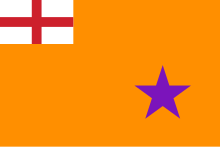Orange Order

The Orange Order ( English Orange Order or Orange Lodge ) is an organization of mostly radical Protestants in Northern Ireland , which has branches in Scotland and other regions within the Commonwealth and in the USA . The order is after Wilhelm III. named by Orange , who defeated the Catholic Stuart King James II and his Irish Catholic army in the Battle of the Boyne in 1690 . The Oraniertag is celebrated on 12 July.
history
In 1795, the first Orange Order was established in Loughgall , County Armagh , to commemorate the victory of Protestantism and to assert claims to superiority over Irish Catholics . By 1900 up to two-thirds of Protestants in Northern Ireland were members of the order. In the 20th century, the Order established the Ulster Paramilitary Defense Association (UDA). By 2000 the order had up to 80,000 members.
Edward Stevenson has been the leader of the order ( Grand Master ) in Ireland since January 2011 , replacing Robert Saulters , who has been in office since 1996 .
Historical meaning
Due to the ethnic division of the country, social housing and jobs were given to Protestants in the big cities .
Origin of name
The name of the Orange Order is based on Wilhelm III. attributed to England. It comes from the House of Orange , whose corporate color is orange . For this reason, the primary colors of the Order is in the Netherlands popular (also because of the royal house of Orange) Orange .
Political importance
In Northern Ireland, we know the phenomenon of Marching Season ( German "marching season" ), in each year of the Battle of the Boyne is thought of 12 July 1690th The order carries out parades that repeatedly lead through Catholic quarters, which often leads to bloody conflicts.
After the police and the military often sided with the order up until the 1990s under the pretext of protecting the right to demonstrate as well as law and order, efforts to de-escalate later, for example by choosing other routes, came to the fore. In 2010 the violence was perpetrated by Protestant youth and members of the radical Ulster Freedom Fighters after the Northern Irish authorities banned marches through Catholic neighborhoods.
See also
literature
- Eric P. Kaufmann: The Orange Order: A Contemporary Northern Irish History. Oxford University Press, Oxford 2007, ISBN 978-0-19-920848-7 .
Web links
- Official website (English)
Individual evidence
- ^ The Irish Times : Orange Order-elects new leader , Jan. 5, 2011
